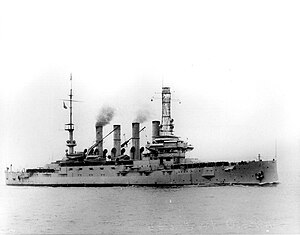 USS North Carolina
| |
| Class overview | |
|---|---|
| Builders | |
| Operators | |
| Preceded by | Pennsylvania class |
| Succeeded by | None |
| Built | 1903–1906 |
| In commission | 1906–1946 |
| Completed | 4 |
| Lost | 1 |
| Scrapped | 3 |
| General characteristics | |
| Type | Armored cruiser |
| Displacement |
|
| Length | 504 ft 6 in (153.8 m) |
| Beam | 72 ft 10 in (22.2 m) |
| Draft | 25 ft (7.6 m) |
| Installed power | 23,000 ihp (17,150 kW) |
| Propulsion |
|
| Speed | 22 knots (41 km/h; 25 mph) |
| Complement | 887 officers and enlisted |
| Armament |
|
| Armor |
|
The Tennessee-class cruisers were four armored cruisers built for the United States Navy between 1903 and 1906. Their main armament of four 10-inch (254 mm) guns in twin turrets was the heaviest carried by any American armored cruiser. Their armor was thinner than that of the six Pennsylvanias which immediately preceded them, a controversial but inevitable decision due to newly imposed congressional restraints on tonnage for armored cruisers and the need for them to be able to steam at 22 knots (41 km/h; 25 mph). However, the fact their armor covered a wider area of the ship than in the Pennsylvanias and their increased firepower caused them to be seen by the Navy as an improvement.
The Tennessees were the largest and last American armored cruisers built, a response to foreign developments and the changing notion of the armored cruiser from fast scout, convoy escort and commerce raider to auxiliary capital ship in a battle line, despite its thin armor protection compared to that of battleships. The Battle of Tsushima in 1905 was seen to validate this concept. While they were being built, questions remained in U.S. naval circles over whether they possessed enough speed, armament or armor to perform their intended duties adequately. They were generally considered armed and protected strongly enough to combat an enemy armored cruiser successfully. Even so, it was generally conceded that with this class a limit had been reached and that the modern armored cruiser no longer exemplified the logical principles of attack and defense in warship design, which meant using the most efficient weapon to its desired end. The appearance of the British Invincible-class battlecruisers, with their greater speed and firepower, ensured their obsolescence as fighting units.
All four ships in this class were given the hull classification symbol CA (armored cruiser) when the Navy adopted that system in 1920, and renamed by then so their original names could be used for new battleships. USS Tennessee, renamed Memphis, was wrecked by a tsunami while at anchor in Santo Domingo harbor in 1916. The other three ships served in World War I. The Navy considered modernization in 1922 and 1928 to upgrade their speed and fighting capability but this did not materialize. USS North Carolina, renamed Charlotte, and USS Montana, renamed Missoula, were scrapped under the terms of the London Naval Treaty, which set an aggregate tonnage limit for the Navy's cruisers, and the new heavy cruisers of the Pensacola class and subsequent classes were entering service. USS Washington, renamed Seattle, was reclassified in 1931 and served as a receiving ship and floating barracks until scrapped in 1946.